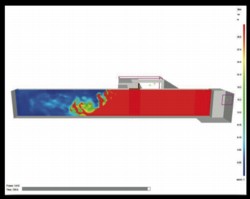Colt reduces cost and space requirements of evacuation from residential buildings

A smoke-ventilation system for residential buildings being trialled by Colt in a project in Manchester enables the escape distance in a corridor to be more than doubled.
The number of staircases needed to provide means of escape from residential buildings can be considerably reduced by a smoke-ventilation system developed by Colt International. With local-authority approval the system is being installed in a residential building at the Angel Meadows development in Manchester. By extending the escape distance in the corridor from 7.5 to 18 m in one direction, the system has made it possible to omit one staircase, gaining usable space and reducing building costs. Computational Fluid Dynamic models show that Colt’s extended corridor solution will out-perform the smoke-clearing capabilities of conventional dead-end corridors that are compliant with Approved Document B. This document refers to corridors limited to an escape distance of 7.5 m or less, relying on automatic opening vents of 1.5 m2 free area for smoke evacuation. This is performance is achieved by a extraction system at one end of the corridor and a dedicated air-inlet system at the other. Inlet air prevents the corridor becoming excessively depressurised, which could make it difficult for people escaping and fire fighters to open doors — as well as causing extract fans to stall, resulting in total system failure.
Related links:









